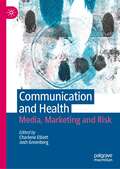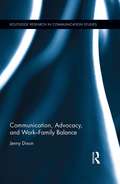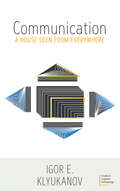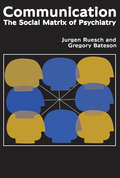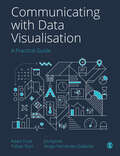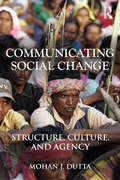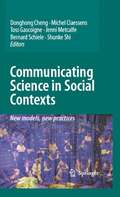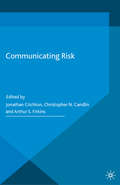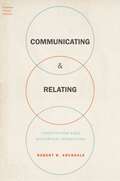- Table View
- List View
Communication and Information Technologies Annual: Politics, Participation, And Production (Studies in Media and Communications #9)
by Laura Robinson Shelia Cotten Jeremy SchulzSponsored by the Communication and Information Technologies Section of the American Sociological Association, this volume brings together nine studies of the digital public sphere. The contributions illuminate three key areas of digital citizenship, namely political engagement, participation networks, and content production. In the first section, authors address relationships including: new media and efficacy, YouTube and young voters, political interest and online news. In the following section, the contributions speak to the importance of participation in social, scholarly, familial, and support networks. Subsequently, in section three on production, two contributions offers insight into unequal production, more specifically, gendered digital production inequalities and the varied responsiveness of microbloggers to different kinds of media events and issues. As a whole, the contributions revisit old questions and answer important new queries about netizenship and the digital public sphere.
Communication and Health: Media, Marketing and Risk
by Charlene Elliott Josh GreenbergThis book explores the unique contribution that critical communication studies can bring to our understanding of health. It covers several broad themes: representing and mediating health; marketing and promoting health, co-producing health; and managing health crises and risks. Chapters speak to moral and social regulation through health communication, technologies of health, healthism and governmentality. They engage with historical and contemporary issues, offering readers theoretically grounded perspectives. At base, the book explores what a critical communication approach to health might look like, revealing in important—and sometimes surprising—ways how communication sits at the centre of understanding how health is constructed, contested, and made meaningful.
Communication and Community in the New Media Age (China Perspectives)
by Wang BinThis book investigates the relationship between information communication and community development in China in the new media age, drawing on theoretical resources from journalism, communication, urban sociology, community management, and the activities of social movements. Contrasting existing scholarship that centers on new technologies and virtual aspects of today’s communication, the study highlights community residents’ daily praxis in real social spaces and the interaction between online and offline communications. Through content analysis, case studies, questionnaire surveys, and in-depth interviews, the author explores the social engagement of communication in public expressions and negotiations among Chinese urban communities. From micro, meso and macro levels respectively, three interactive mechanisms are discussed: (1) media use and social consciousness and mobilization; (2) new media and changes in community governance; and (3) state-community interplay. Based on these mechanisms, the author proposes the idea of “the construction of grassroots social communication”, exploring approaches to the modernization of social governance and attainment of social interests by optimizing information communication. Communication and Community in the New Media Age will appeal to academics and students studying communication and social transition in China, new media and society, urban sociology, and public governance.
Communication and Community in the New Media Age (China Perspectives)
by Wang BinThis book investigates the relationship between information communication and community development in China in the new media age, drawing on theoretical resources from journalism, communication, urban sociology, community management, and the activities of social movements. Contrasting existing scholarship that centers on new technologies and virtual aspects of today’s communication, the study highlights community residents’ daily praxis in real social spaces and the interaction between online and offline communications. Through content analysis, case studies, questionnaire surveys, and in-depth interviews, the author explores the social engagement of communication in public expressions and negotiations among Chinese urban communities. From micro, meso and macro levels respectively, three interactive mechanisms are discussed: (1) media use and social consciousness and mobilization; (2) new media and changes in community governance; and (3) state-community interplay. Based on these mechanisms, the author proposes the idea of “the construction of grassroots social communication”, exploring approaches to the modernization of social governance and attainment of social interests by optimizing information communication. Communication and Community in the New Media Age will appeal to academics and students studying communication and social transition in China, new media and society, urban sociology, and public governance.
Communication Against Domination: Ideas of Justice from the Printing Press to Algorithmic Media
by Max HänskaThis book tackles the philosophical challenge of bridging the gap between empirical research into communication and information technology, and normative questions of justice and how we ought to communicate with each other. It brings the question of what justice demands of communication to the center of social science research. Max Hänska undertakes expansive philosophical analysis to locate the proper place of normativity in social science research, a looming subject in light of the sweeping roles of information technologies in our social world today. The book’s first section examines metatheoretical issues to provide a framework for normative analysis, while the second applies this framework to three technological epochs: broadcast communication, the Internet and networked communications, and the increasing integration of artificial intelligence and machine learning technologies into our communication systems. Hänska goes beyond the prevailing frameworks in the field by exploring how we answer normative questions and how our answer can change depending on our social context and the affordances of prevailing communications technologies. This book provides an essential guide for scholars as well as graduate and advanced undergraduate students of research and theory in communication, philosophy, political science, and the social sciences.
Communication Against Domination: Ideas of Justice from the Printing Press to Algorithmic Media
by Max HänskaThis book tackles the philosophical challenge of bridging the gap between empirical research into communication and information technology, and normative questions of justice and how we ought to communicate with each other. It brings the question of what justice demands of communication to the center of social science research. Max Hänska undertakes expansive philosophical analysis to locate the proper place of normativity in social science research, a looming subject in light of the sweeping roles of information technologies in our social world today. The book’s first section examines metatheoretical issues to provide a framework for normative analysis, while the second applies this framework to three technological epochs: broadcast communication, the Internet and networked communications, and the increasing integration of artificial intelligence and machine learning technologies into our communication systems. Hänska goes beyond the prevailing frameworks in the field by exploring how we answer normative questions and how our answer can change depending on our social context and the affordances of prevailing communications technologies. This book provides an essential guide for scholars as well as graduate and advanced undergraduate students of research and theory in communication, philosophy, political science, and the social sciences.
Communication, Advocacy, And Work-family Balance (PDF)
by Jenny DixonThis book presents an understanding of work-family balance for working adults belonging to a number of different family structures (e.g. single and/or childfree adults, LGBT couples, families with female breadwinners). It contends that family structure should serve as a way of thinking about diversity (i.e., race, gender, age, family) in the U.S. workplace. It also argues that―in addition to accommodations occurring through workplace policy―the negotiation of work-family balance happens as a result of self-advocacy that occurs in everyday communication about family at work. Relaying the stories of a number of different working adults belonging to a variety of different family structures, it explores the range of obstacles faced in the attempt at balancing work and family life, generates informed ideas for eliminating barriers commonly experienced in balancing work and family, and problematizes enduring assumptions regarding gender roles and the myth of steadfast public and private spheres.
Communication, Advocacy, and Work/Family Balance (Routledge Research in Communication Studies)
by Jenny DixonThis book presents an understanding of work-family balance for working adults belonging to a number of different family structures (e.g. single and/or childfree adults, LGBT couples, families with female breadwinners). It contends that family structure should serve as a way of thinking about diversity (i.e., race, gender, age, family) in the U.S. workplace. It also argues that—in addition to accommodations occurring through workplace policy—the negotiation of work-family balance happens as a result of self-advocacy that occurs in everyday communication about family at work. Relaying the stories of a number of different working adults belonging to a variety of different family structures, it explores the range of obstacles faced in the attempt at balancing work and family life, generates informed ideas for eliminating barriers commonly experienced in balancing work and family, and problematizes enduring assumptions regarding gender roles and the myth of steadfast public and private spheres.
Communication, Advocacy, and Work/Family Balance (Routledge Research in Communication Studies)
by Jenny DixonThis book presents an understanding of work-family balance for working adults belonging to a number of different family structures (e.g. single and/or childfree adults, LGBT couples, families with female breadwinners). It contends that family structure should serve as a way of thinking about diversity (i.e., race, gender, age, family) in the U.S. workplace. It also argues that—in addition to accommodations occurring through workplace policy—the negotiation of work-family balance happens as a result of self-advocacy that occurs in everyday communication about family at work. Relaying the stories of a number of different working adults belonging to a variety of different family structures, it explores the range of obstacles faced in the attempt at balancing work and family life, generates informed ideas for eliminating barriers commonly experienced in balancing work and family, and problematizes enduring assumptions regarding gender roles and the myth of steadfast public and private spheres.
Communication Activities with Adults
by Jayne Comins Felicity Llewellyn Judy OffilerWith more than 100 graded communication activities for individuals and groups, this practical book is an excellent resource for health professionals and activity providers. An extensively revised and updated form of the extremely popular "Activities Ideas", which was originally published in 1983, this book was originally compiled for use with people with dysphasia. This book is also valuable for working with the elderly and day-centre clients, and can be used for group warm-ups. The majority of activities require little or no preparation and can be adapted to suit different abilities.
Communication Activities with Adults
by Jayne Comins Felicity Llewellyn Judy OffilerWith more than 100 graded communication activities for individuals and groups, this practical book is an excellent resource for health professionals and activity providers. An extensively revised and updated form of the extremely popular "Activities Ideas", which was originally published in 1983, this book was originally compiled for use with people with dysphasia. This book is also valuable for working with the elderly and day-centre clients, and can be used for group warm-ups. The majority of activities require little or no preparation and can be adapted to suit different abilities.
Communication: A House Seen from Everywhere (Studies in Linguistic Anthropology #2)
by Igor E. KlyukanovFocusing on the scientific study of communication, this book is a systematic examination. To that end, the natural, social, cultural, and rational scientific perspectives on communication are presented and then brought together in one unifying framework of the semiotic square, showing how all four views are interconnected. The question of whether the study of communication can be considered a unique science is addressed. It is argued that communication is never separate from any object of study and thus we always deal with its manifestations, captured in the four scientific perspectives discussed in the book.
Communication: The Social Matrix of Psychiatry
by Jurgen Ruesch Gregory Bateson Eve C. Pinsker Gene CombsThe integration of psychiatry into the mainstream of American society following World War II involved rethinking and revision of psychiatric theories. While in the past, theories of personality had been concerned with the single individual, this pioneering volume argues that such theories are of little use. Instead, the individual must be seen in the context of social situations in which rapid advances in communication technology have brought people closer together, changing their behavior and self-expression. Ruesch and Bateson show that following World War II mass communication and culture have become so pervasive that no individual or group can escape their influences for long. Therefore, they argue that processes of psychoanalysis must now consider the individual within the framework of a social situation. Focusing upon the larger societal systems, of which both psychiatrist and patient are an integral part, they develop concepts that encompass large-scale events as well as happenings of an individual nature. They have outlined this relationship in a unified theory of communication, which encompasses events linking individual to individual, individual to the group, and ultimately, to events of worldwide concern. The term "social matrix," then, refers to a larger scientific system, of which both the psychiatrist and the patient are integral parts. Jurgen Ruesch was professor of psychiatry at the University of California School of Medicine and director of the section of Social Psychiatry at the Langley Porter Neuropsychatric Institute in San Francisco. Gregory Bateson taught at Columbia University, the New School for Social Research, Harvard University, Stanford University, and the University of California, Santa Cruz. Among his books are "Naven", "Steps to an Ecology of Mind, Mind and Nature: A Necessary Unity", "Angels Fear: Towards an Epistemology of the Sacred", and "A Sacred Unity: Further Steps to an Ecology of Mind".
Communication: The Social Matrix of Psychiatry
by Jurgen Ruesch Gregory Bateson Eve C. Pinsker Gene CombsThe integration of psychiatry into the mainstream of American society following World War II involved rethinking and revision of psychiatric theories. While in the past, theories of personality had been concerned with the single individual, this pioneering volume argues that such theories are of little use. Instead, the individual must be seen in the context of social situations in which rapid advances in communication technology have brought people closer together, changing their behavior and self-expression. Ruesch and Bateson show that following World War II mass communication and culture have become so pervasive that no individual or group can escape their influences for long. Therefore, they argue that processes of psychoanalysis must now consider the individual within the framework of a social situation. Focusing upon the larger societal systems, of which both psychiatrist and patient are an integral part, they develop concepts that encompass large-scale events as well as happenings of an individual nature. They have outlined this relationship in a unified theory of communication, which encompasses events linking individual to individual, individual to the group, and ultimately, to events of worldwide concern. The term "social matrix," then, refers to a larger scientific system, of which both the psychiatrist and the patient are integral parts. Jurgen Ruesch was professor of psychiatry at the University of California School of Medicine and director of the section of Social Psychiatry at the Langley Porter Neuropsychatric Institute in San Francisco. Gregory Bateson taught at Columbia University, the New School for Social Research, Harvard University, Stanford University, and the University of California, Santa Cruz. Among his books are "Naven", "Steps to an Ecology of Mind, Mind and Nature: A Necessary Unity", "Angels Fear: Towards an Epistemology of the Sacred", and "A Sacred Unity: Further Steps to an Ecology of Mind".
Communicating with Data Visualisation: A Practical Guide
by Adam Frost Tobias Sturt Jim Kynvin Sergio GallardoHow can you transform a spreadsheet of numbers into a clear, compelling story that your audience will want to pass on? This book is a step-by-step guide to bringing data to life through visualisations, from static charts and maps to interactive infographics and motion graphics. Introducing a four-step framework to creating engaging and innovative visualisations, it helps you to: · Find the human stories in your datasets · Design a visual story that will resonate with your audience · Make a clear, persuasive visual that represents your data truthfully · Refine your work to ensure your visual expresses your story in the best possible way. This book also includes a portfolio of best-practice examples and annotated templates to help you choose the right visual for the right audience, and repurpose your work for different contexts.
Communicating with Data Visualisation: A Practical Guide
by Adam Frost Tobias Sturt Jim Kynvin Sergio GallardoHow can you transform a spreadsheet of numbers into a clear, compelling story that your audience will want to pass on? This book is a step-by-step guide to bringing data to life through visualisations, from static charts and maps to interactive infographics and motion graphics. Introducing a four-step framework to creating engaging and innovative visualisations, it helps you to: · Find the human stories in your datasets · Design a visual story that will resonate with your audience · Make a clear, persuasive visual that represents your data truthfully · Refine your work to ensure your visual expresses your story in the best possible way. This book also includes a portfolio of best-practice examples and annotated templates to help you choose the right visual for the right audience, and repurpose your work for different contexts.
Communicating with Data Visualisation: A Practical Guide
by Adam Frost Tobias Sturt Jim Kynvin Sergio GallardoHow can you transform a spreadsheet of numbers into a clear, compelling story that your audience will want to pass on? This book is a step-by-step guide to bringing data to life through visualisations, from static charts and maps to interactive infographics and motion graphics. Introducing a four-step framework to creating engaging and innovative visualisations, it helps you to: · Find the human stories in your datasets · Design a visual story that will resonate with your audience · Make a clear, persuasive visual that represents your data truthfully · Refine your work to ensure your visual expresses your story in the best possible way. This book also includes a portfolio of best-practice examples and annotated templates to help you choose the right visual for the right audience, and repurpose your work for different contexts.
Communicating with Children and Their Families: Responding To Need And Protection (UK Higher Education OUP Humanities & Social Sciences Health & Social Welfare)
by Liz Davies Evelyn Kerrigan LeblochGood communication skills are essential for effective social work practice. This book brings current, relevant and contested areas of social work practice to life by using scripts from real life situations to demonstrate every day scenarios social workers encounter when communicating with children and their families.Each chapter takes a key aspect of communication: engagement; negotiation; investigation; use of power and persistence and presents it in a context of good professional practice. It also examines the common pitfalls that workers could fall into and contextualises the script through comparison with a contemporary case study. Relevant theoretical frameworks, legislation, policy and ethical dilemmas are included for each situation. This engaging and innovative book gives social work students and professionals a thorough understanding of the best ways to communicate with children and their families in complex and challenging situations. The book also has relevance to other professionals such as those working in health, education, police and the voluntary sector.
Communicating the UX Vision: 13 Anti-Patterns That Block Good Ideas
by James O'Brien Martina SchellThis book identifies the 13 main challenges designers face when they talk about their work and provides communication strategies so that a better design, not a louder argument, is what makes it into the world. It is a fact that we all want to put great design into the world, but no product ever makes it out of the building without rounds of reviews, feedback, and signoff. As an interaction or UX designer, you’ve felt the general trend toward faster development, more work, and less discussion. As we spend time crafting, we become attached to our own ideas and it gets all too easy to react to feedback emotionally or dismiss it, when we should be taking the time to decode it and explain or adapt the design. Communicating the UX Vision helps you identify the skills and behavioral patterns to present your work in more persuasive ways, and respond more constructively to feedback from coworkers and stakeholders.Learn presentation tips that make stakeholders and other departments take your designs more seriouslyUncover valuable techniques to make feedback sessions more productiveUnderstand how to improve empathy with business stakeholders and learn to speak their language betterDiscover how to better understand your behavior and identify your personal anti-patterns
Communicating Social Change: Structure, Culture, and Agency (Routledge Communication Series)
by Mohan J. DuttaCommunicating Social Change: Structure, Culture, and Agency explores the use of communication to transform global, national, and local structures of power that create and sustain oppressive conditions. Author Mohan J. Dutta describes the social challenges that exist in current globalization politics, and examines the communicative processes, strategies, and tactics through which social change interventions are constituted in response to the challenges. Using empirical evidence and case studies, he documents the ways through which those in power create conditions at the margins, and he provides a theoretical base for discussing the ways in which these positions of power are resisted through communication processes, strategies, and tactics. The interplay of power and control with resistance is woven through each of the chapters in the book. This exceptional volume highlights the points of intersection between the theory and praxis of social change communication, creating theoretical entry points for the praxis of social change. It is intended for communication scholars and students studying activism, social movements, and communication for social change, and it will also resonate in such disciplines such as development, sociology, and social work, with those who are studying social transformations.
Communicating Social Change: Structure, Culture, and Agency (Routledge Communication Series)
by Mohan J. DuttaCommunicating Social Change: Structure, Culture, and Agency explores the use of communication to transform global, national, and local structures of power that create and sustain oppressive conditions. Author Mohan J. Dutta describes the social challenges that exist in current globalization politics, and examines the communicative processes, strategies, and tactics through which social change interventions are constituted in response to the challenges. Using empirical evidence and case studies, he documents the ways through which those in power create conditions at the margins, and he provides a theoretical base for discussing the ways in which these positions of power are resisted through communication processes, strategies, and tactics. The interplay of power and control with resistance is woven through each of the chapters in the book. This exceptional volume highlights the points of intersection between the theory and praxis of social change communication, creating theoretical entry points for the praxis of social change. It is intended for communication scholars and students studying activism, social movements, and communication for social change, and it will also resonate in such disciplines such as development, sociology, and social work, with those who are studying social transformations.
Communicating Science in Social Contexts: New models, new practices
by Donghong Cheng Michel Claessens Nicholas R. J. Gascoigne Jenni Metcalfe Bernard Schiele Shunke ShiScience communication, as a multidisciplinary field, has developed remarkably in recent years. It is now a distinct and exceedingly dynamic science that melds theoretical approaches with practical experience. Formerly well-established theoretical models now seem out of step with the social reality of the sciences, and the previously clear-cut delineations and interacting domains between cultural fields have blurred. Communicating Science in Social Contexts examines that shift, which itself depicts a profound recomposition of knowledge fields, activities and dissemination practices, and the value accorded to science and technology. Communicating Science in Social Contexts is the product of long-term effort that would not have been possible without the research and expertise of the Public Communication of Science and Technology (PCST) Network and the editors. For nearly 20 years, this informal, international network has been organizing events and forums for discussion of the public communication of science.
Communicating Science and Technology in Society: Issues of Public Accountability and Engagement
by Ana Delicado Fabienne Crettaz Von Roten Katarina PrpićThis volume addresses the engagement between science and society from multiple viewpoints. At a time when trust in experts is being questioned, misinformation is rife and scientific and technological development show growing social impact, the volume examines the challenges in involving the public in scientific debates and decisions. It takes into account societal needs and concerns in research, and analyses the interface between the roles of institutions and individuals. From environmental challenges to science communication, participatory technological design to animal experimentation, and transdisciplinarity to norms and values in science, the volume brings together research on areas in which scientists and citizens interact, across diverse, often understudied, socio-cultural contexts in Europe. It encompasses the natural sciences, engineering and the social sciences, and the chapters follow diverse theoretical frameworks and methodologies, including both quantitative and qualitative approaches. This volume contributes not just to scholarly knowledge on the topic of science and society relations, but also provides useful information for students, policy makers, journalists, and STEM (science, technology, engineering and mathematics) researchers keen on engaging with their publics and conducting responsible research and innovation.
Communicating Risk (Communicating in Professions and Organizations)
by Steven BerbecWe live in world increasingly shaped by risk, a fact underscored by recent events in the financial markets, science and technology, environmental policy and biosecurity, law enforcement and criminal justice. Risk assessment has become a central concern of governments, organisations and the professions, and the communication of risk is a crucial part of professional work. Exploring how risk is discursively constructed across these domains is therefore central to our understanding of how professional practice affects people's lives. Communicating Risk takes up this challenge, with contributions from leading researchers and practitioners that examine key issues of risk communication across diverse professional domains.
Communicating & Relating: Constituting Face in Everyday Interacting (Foundations of Human Interaction)
by Robert B. ArundaleCommunicating & Relating offers an account of how relating with one another emerges in communicating in everyday interacting. Prior work has indicated that human relationships arise in human communicating, and some studies have made arguments for why that is the case. Communicating & Relating moves beyond this work to offer an account of how both relating and face emerge in everyday talk and conduct: what comprises human communicating, what defines human social systems, how the social and the individual are linked in human life, and what comprises human relating and face. Part 1 develops the Conjoint Co-constituting Model of Communicating to address the question "How do participants constitute turns, actions, and meanings in everyday interacting?" Part 2 argues that the processes of constituting what is known cross-culturally as "face" are the processes of constituting relating, and develops Face Constituting Theory to address the question "How do participants constitute relating in everyday interacting?" The answers to both questions are grounded in evidence from everyday talk and conduct. Like other volumes in the Foundations of Human Interaction series, Communicating & Relating offers new perspectives and new research on communicative interaction and on human relationships as key elements of human sociality.

